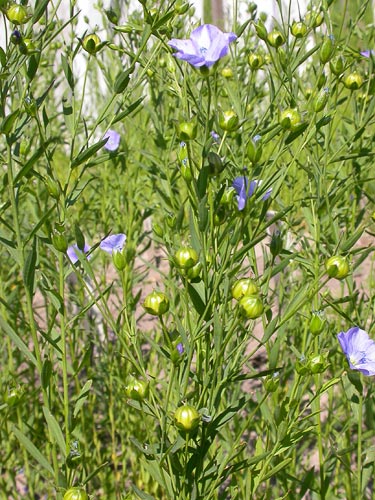Relatives
Linum humile Mill. - Crown flax, oil flax.
Taxonomic position.
Family Linaceae S.F.Gray, genus Linum L.Synonyms.
L. indehiscens subsp. eurasiaticum prol. brevimulticaulia Vav.et Ell., L.usitatissimum var.humile Mill. Bondar., L.usitatissimum subsp. humile (Mill.) Czernom.Morphology and biology.
Herbaceous annual plant, 30-50 (70) cm tall. This is a bushy plant with two or more stems branching from the bottom. Leaves are 2-3 cm long and 4-5 mm wide, linear-lanceolate, acute on top, smoky blue, with three veins, sessile, spirally and densely arranged on the stem. Flowers are androgynous, pentamerous. Sepals are loose, persistent with fruit, 5-6 mm long, ovate-lanceolate, acuminate; internal ones are white and scarious along the edges. Flowers are numerous, 1.5-2.5 cm in diameter, set on long pedicels that exceed sepals in length. Petals are 14-18 mm long, light or deep blue. Fruit is a pod 6-8 mm long and 5.7-7 mm in diameter, globular, slightly depressed, yellowish; pod septa are ciliate, less frequently bare. There are 10 seeds in one pod. Seed are ovoid, very oblate, brown, smooth and glossy, 5-6.3 mm long. Entomophilous. Blossoms in May/June; bears fruit in June/July. 2n=30.Distribution.
Distributed throughout forest-steppe and steppe zones of the European part of Russia and Ukraine, the Crimea, the Caucasus, Western Siberia (not frequent), Middle Asia, Asia Minor, the Iranian Plateau, Kashgaria, and China. Cultivated as a spring crop; also grows as a feral plant where it has escaped from cultivation.Ecology.
Mesoxerophyte. Endures hot and dry climates. Grows in ruderal sites, along roadsides, near homesteads, and as a weed.Utilization and economic value.
Industrial (oil-producing) and medicinal herb. Flax seeds contain 30-48% fatty drying oil, 18-33% protein, 12-26% carbohydrates, mucilage (5-12%), organic acids, enzymes, carotene, potassium, calcium, magnesium, iron, manganese, zinc, etc.Reference citations:
Brezhnev D.D., Korovina O.N. 1981. Wild relatives of cultivated plants in the flora of the USSR. Leningrad: Kolos, 309-310 pp. (In Russian)Shishkin B.K., Nikitin V.V., eds. 1950. Flora of Turkmenia. Vol. 5. Ashkhabad: Publishing House of the Turkmenian Branch of the USSR Academy of Sciences, 19 pp. (In Russian)


